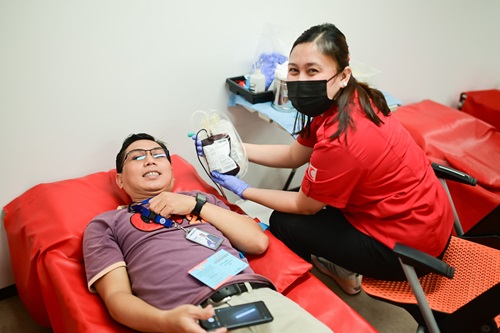Blood Donation in Singapore: A Lifeline for the Nation’s Healthcare

Blood donation is a critical component of Singapore’s healthcare system, providing a lifeline to thousands of patients each year. Despite being a small nation, Singapore has built an efficient and effective blood donation infrastructure that ensures a steady supply of blood and blood products for medical treatments, surgeries, and emergencies. This article explores the importance of blood donation in Singapore, the processes involved, and how the community plays a vital role in sustaining this essential service.
1. The Importance of Blood Donation
Meeting the Nation’s Medical Needs:
- Blood donation is essential for various medical procedures, including surgeries, cancer treatments, trauma care, and the management of chronic conditions such as thalassemia. The demand for blood in Singapore is constant, with hospitals and medical facilities requiring a stable supply to save lives and improve patient outcomes.
Supporting Emergency Preparedness:
- In times of crisis, such as natural disasters, major accidents, or public health emergencies, the need for blood can surge dramatically. Having a robust blood donation system ensures that Singapore is prepared to respond swiftly and effectively to such situations, providing the necessary support to healthcare providers.
Aiding in Life-Saving Treatments:
- Blood and its components—such as red blood cells, plasma, and platelets—are vital for various life-saving treatments. For example, patients undergoing chemotherapy often require platelet transfusions, while those with severe anemia may need red blood cell transfusions. Regular blood donations help maintain an adequate supply of these components, ensuring that patients receive the care they need.
2. The Blood Donation Process in Singapore
Eligibility and Requirements:
- Blood donation in Singapore is open to healthy individuals aged between 16 and 60 years old, with those under 18 requiring parental consent. Donors must meet certain health criteria, including a minimum weight of 45 kg and a hemoglobin level of at least 12.5 g/dL for females and 13.0 g/dL for males. Additionally, donors must be free from chronic illnesses and have not engaged in high-risk behaviors that could affect the safety of the blood supply.
Donation Types:
- In Singapore, there are several types of blood donations:
- Whole Blood Donation: This is the most common type, where a donor gives approximately 350-450 ml of whole blood in one session. The blood is then separated into its components—red blood cells, plasma, and platelets—for use in different medical treatments.
- Apheresis Donation: Apheresis is a specialized donation process where only specific components of the blood, such as platelets or plasma, are collected. The remaining components are returned to the donor’s bloodstream. This type of donation is particularly important for patients requiring high doses of a particular blood component.
- Autologous Donation: In some cases, patients scheduled for surgery may donate their own blood in advance. This blood is stored and later used during their surgery, reducing the risk of transfusion-related complications.
Donation Centers and Mobile Drives:
- Blood donations can be made at several locations across Singapore, including:
- Bloodbanks: Operated by the Health Sciences Authority (HSA) in collaboration with the Singapore Red Cross (SRC), blood banks are located at hospitals such as the Singapore General Hospital, Health Sciences Authority (HSA), Woodlands, and Dhoby Ghaut. These centers provide a controlled environment for safe and comfortable blood donations.
- Mobile Blood Donation Drives: To make blood donation more accessible, the SRC regularly organizes mobile blood donation drives at various locations, including community centers, schools, workplaces, and shopping malls. These mobile drives play a crucial role in reaching out to new donors and maintaining a steady supply of blood.
The Donation Procedure:
- The blood donation process in Singapore is streamlined and donor-friendly. It typically involves the following steps:
- Registration: Donors provide personal details and undergo a brief health assessment, including a questionnaire about their medical history and lifestyle.
- Health Screening: A healthcare professional checks the donor’s hemoglobin level and vital signs to ensure they are fit to donate.
- Donation: The actual blood donation takes about 5-10 minutes for whole blood donations, while apheresis donations may take longer. The donor is seated comfortably, and sterile, single-use equipment is used to collect the blood.
- Post-Donation Care: After the donation, donors are advised to rest briefly and are provided with refreshments to help them recover. Donors are also given post-donation care instructions to ensure their well-being.
3. The Role of the Community and Organizations
Singapore Red Cross (SRC):
- The Singapore Red Cross (SRC) is the national blood donor recruiter and plays a pivotal role in the blood donation ecosystem. The SRC organizes blood donation drives, raises awareness about the importance of blood donation, and works closely with the Health Sciences Authority (HSA) to ensure a steady supply of safe blood.
Corporate and Community Involvement:
- Companies and community organizations in Singapore actively participate in blood donation initiatives through corporate social responsibility (CSR) programs. Many businesses organize blood donation drives at their premises, encouraging employees to donate. Schools, religious groups, and civic organizations also contribute by hosting regular blood donation events.
Youth Involvement:
- Engaging young people in blood donation is crucial for sustaining the nation’s blood supply. The SRC and other organizations work closely with educational institutions to promote blood donation among students, fostering a culture of giving and community service from a young age.
4. Challenges and Future Directions
Meeting the Demand:
- One of the ongoing challenges in Singapore’s blood donation efforts is meeting the increasing demand for blood, especially as the population ages and the need for medical care rises. Continuous recruitment of new donors and retention of regular donors are essential to maintaining a sufficient blood supply.
Addressing Myths and Misconceptions:
- Myths and misconceptions about blood donation can deter potential donors. Common concerns include fears about the safety of the donation process, the impact on health, and the belief that certain health conditions disqualify individuals from donating. Public education campaigns are vital in addressing these concerns and encouraging more people to donate.
Innovations in Blood Donation:
- Advances in technology and medical research are likely to shape the future of blood donation in Singapore. Innovations such as blood substitutes, improved blood storage techniques, and the potential for lab-grown blood could enhance the efficiency and availability of blood products.
Sustaining Volunteerism and Community Support:
- The success of Singapore’s blood donation system relies heavily on volunteerism and community support. Sustaining this commitment, especially among younger generations, will be key to ensuring a reliable blood supply for the future.
Conclusion
Blood donation is a cornerstone of Singapore’s healthcare system, ensuring that life-saving treatments are available to those in need. The combined efforts of the government, the Singapore Red Cross, corporate entities, and the community have created a well-organized and effective blood donation infrastructure. However, the continued success of this system depends on the ongoing support of donors and the broader community. By fostering a culture of regular blood donation and addressing challenges proactively, Singapore can continue to meet the blood needs of its population and uphold its commitment to saving lives.



